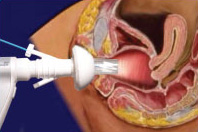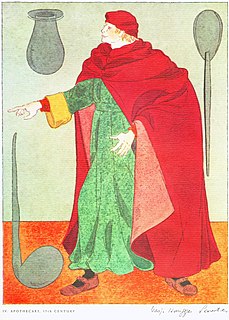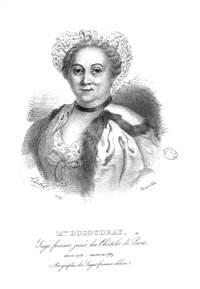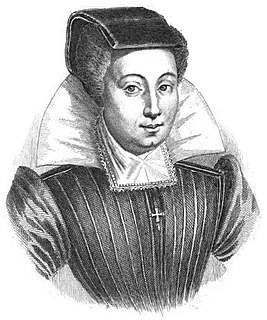Related Research Articles
Obstetrics is the field of study concentrated on pregnancy, childbirth and the postpartum period. As a medical specialty, obstetrics is combined with gynecology under the discipline known as obstetrics and gynecology (OB/GYN), which is a surgical field.

Gynaecology or gynecology is the medical practice dealing with the health of the female reproductive system. Almost all modern gynaecologists are also obstetricians. In many areas, the specialities of gynaecology and obstetrics overlap.

Trotula is a name referring to a group of three texts on women's medicine that were composed in the southern Italian port town of Salerno in the 12th century. The name derives from a historic female figure, Trota of Salerno, a physician and medical writer who was associated with one of the three texts. However, "Trotula" came to be understood as a real person in the Middle Ages and because the so-called Trotula texts circulated widely throughout medieval Europe, from Spain to Poland, and Sicily to Ireland, "Trotula" has historic importance in "her" own right.

Agnodice or Agnodike is a legendary figure credited as the first female midwife or physician in ancient Athens. Her story is told by the Roman author Gaius Julius Hyginus in his Fabulae. Agnodice is not generally believed to be a historical figure, but her story has been frequently deployed as a precedent for women practising midwifery or medicine, or as an argument against either of these.

Apothecary is a mostly archaic term for a medical professional who formulates and dispenses materia medica (medicine) to physicians, surgeons, and patients. The modern chemist or pharmacist has taken over this role. In some languages and regions, the word "apothecary" is still used to refer to a retail pharmacy or a pharmacist who owns one. Apothecaries' investigation of herbal and chemical ingredients was a precursor to the modern sciences of chemistry and pharmacology.

Helen King is a British classical scholar and advocate for the medical humanities. She is Professor Emerita of Classical Studies at the Open University. She was previously Professor of the History of Classical Medicine and Head of the Department of Classics at the University of Reading.

Angélique Marguerite Le Boursier du Coudray was an influential, pioneering midwife during her lifetime, who gained fame when men were taking over the field. She rose from middle-class origins to become noticed and commissioned by King Louis XV himself.

The presence of women in medicine, particularly in the practicing fields of surgery and as physicians, has been traced to earliest human history. Women have historically had lower participation levels in medical fields compared to men with occupancy rates varying by race, socioeconomic status, and geography [quotation needed].
Gilbertus Anglicus was a medieval English physician. He is known chiefly for his encyclopedic work, the Compendium of Medicine, most probably written between 1230 and 1250. This medical treatise was an attempt at a comprehensive overview of the best practice in pharmacology, medicine, and surgery at the time. His medical works, alongside those of John of Gaddesden, "formed part of the core curriculum that underpinned the practice of medicine for the next 400 years".

Kate Campbell Hurd-Mead was a pioneering feminist and obstetrician who promoted the role of women in medicine. She wrote A History of Women in Medicine: From the Earliest of Times to the Beginning of the Nineteenth Century in 1938. She was born in Danville, Quebec, Canada, and died in Haddam, Connecticut, United States.
Jacqueline Felice de Almania, was reportedly from Florence, Italy. She was an early 14th-century French physician in Paris, France who was placed on trial in 1322 for unlawful practice.

Louise (Bourgeois) Boursier (1563–1636) was a French Royal Court midwife who delivered babies for many women in her twenty-six year professional career. Marie de Médicis, the wife of Henry the Great of France, was one of her patients, and Bourgeois delivered her six children. Bourgeois' income was about ten times the average midwife's. She believed she was blessed with practical midwifery talents from Phaenarete, the mother of Socrates.
Magistra Hersend, also called Hersend or Magistra Hersend Physica was a French female surgeon who accompanied King Louis IX of France on the Seventh Crusade in 1249. She is one of two women recorded as royal physician or surgeon.
Jewish medicine is medical practice of the Jewish people, including writing in the languages of both Hebrew and Arabic. 28% of Nobel Prize winners in medicine have been Jewish, although Jews comprise less than 0.2% of the world's population.
Midwifery in the Middle Ages impacted women's work and health prior to the professionalization of medicine. During the Middle Ages in Western Europe, people relied on the medical knowledge of Roman and Greek philosophers, specifically Galen, Hippocrates, and Aristotle. These medical philosophers focused primarily on the health of men, and women's health issues were understudied. Thus, these philosophers did not focus on the baby and they encouraged women to handle women's issues. In fact, William L. Minkowski asserted that a male's reputation was negatively affected if he associated with or treated pregnant patients. Resultantly, male physicians did not engage with pregnant patients, and women had a place in medicine as midwives. Myriam Greilsammer notes that an additional opposition to men's involvement in childbearing was that men should not associate with female genitalia throughout the secret practices of childbearing. The prevalence of this mindset allowed women to continue the practice of midwifery throughout most of the Medieval era with little or no male influence on their affairs. Minkowski writes that in Guy de Chauliac's fourteenth-century work Chirurgia magna, "he wrote that he was unwilling to discourse on midwifery because the field was dominated by women." However, changing views of medicine caused the women's role as midwife to be pushed aside as the professionalization of medical practitioners began to go up.

Trota of Salerno was a medical practitioner and writer in the southern Italian coastal town of Salerno who lived in the early or middle decades of the 12th century. Her fame spread as far as France and England in the 12th and 13th centuries. A Latin text that gathered some of her therapies was incorporated into an ensemble of treatises on women's medicine that came to be known as the Trotula, "the little book [called] 'Trotula'". Gradually, readers became unaware that this was the work of three different authors. They were also unconscious of name of the historical writer, which was "Trota" and not "Trotula". The latter was thenceforth misunderstood as the author of the whole compendium. These misconceptions about the author of Trotula contributed to the erasure or modification of her name, gender, level of education, medical knowledge, or the time period in which the texts were written; this trend often resulted from the biases of later scholars. Trota's authentic work was forgotten until it was rediscovered in the late 20th century.
John Bradmore (d.1412) was an English surgeon and metalworker who was author of the Philomena, one of the earliest treatises on surgery. He was a court surgeon during the reign of King Henry IV of England. He is best known for extracting an arrow embedded in the skull of the king's son, the future king Henry V at Kenilworth, after the Battle of Shrewsbury in 1403.
Peretta Peronne was an unlicensed female surgeon operating in Paris in the early fifteenth century.
Monica Green is an author and a historian who was a professor of history at Arizona State University. She is an expert in the history of women's health care in premodern Europe, medicine and gender, and she specialises in the history of infectious diseases in the pre-modern period.